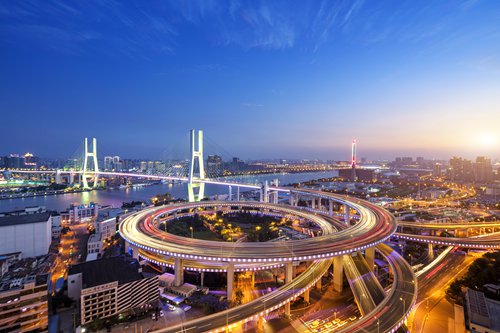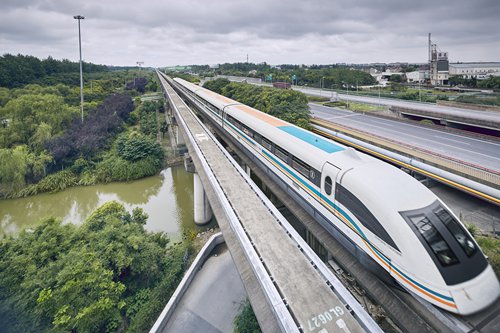METRO SHANGHAI / PULSE
Shanghai Transport & Port Research Center releases 2018 report
Transportation trends

Elevated road and Nanpu Bridge of Shanghai Photos: VCG
Shanghai Transport & Port Research Center recently released the 2018 Development Report of Shanghai Transportation Industry, Shanghai Municipal Transportation Commission announced last week.
In 2017, the Shanghai transportation industry promoted progress in key work such as major construction projects, strengthening areas of weakness in integrated transportation, priority of public transportation and international shipping center construction. The goals and tasks of the year were successfully completed so as to lay a solid foundation for the high-quality development of Shanghai's transportation industry.
The total number of permanent residents in Shanghai dropped to 24.18 million as of the end of 2017, down 14,000 from 2016, according to the report.
Investment in Shanghai transportation infrastructure in 2017 was 72.76 billion ($10.61 billion) yuan, up 4.2 percent from 2016. In terms of public transportation subsidies, buses accounted for 80.5 percent, ranking first, which was followed by the metro, which accounted for 17.2 percent.
By the end of 2017, the ownership of registered vehicles in Shanghai reached 3.9 million, up 8.5 percent from 2016.
International hub
As of the end of 2017, Shanghai's two airports - Hongqiao International Airport and Pudong International Airport - altogether have four terminals and six runways put into use.
Meanwhile, the total length of railways in Shanghai reached 465 kilometers, forming a passenger transport hub layout with three major hubs and three minor hubs.
The total length of all Shanghai roads exceeded 13,000 kilometers as of 2017, up 0.2 percent from 2016. The expressway mileage reached about 830 kilometers, an increase of 0.5 percent from 2016.
In 2017, Shanghai ports had more than 1,100 berths including 900 berths in inland ports. As of the end of 2017, the navigation mileage of inland waterway exceeded 2,000 kilometers. The international hub ports with Yangshan Deep Water Port area and Waigaoqiao Port area as main bodies have been completed.
Shanghai Port International Cruise Terminal has five berths for cruises and Wusongkou International Cruise Terminal has two berths.

Shanghai Maglev train Photos: VCG
Public transport and cars
By the end of 2017, Shanghai metro had 16 lines (including the Maglev) in operation. The total length of all metro lines exceeded 666 kilometers, an increase of 8 percent from 2016.
By 2017, 1,500 bus lines with a total length of 24,000 kilometers were in operation. The total mileage of all completed bus lanes reached 385 kilometers. There are 22 backbone bus passages downtown.
Shanghai has 31 ferry stations and Shanghai's three islands have eight ferry stations. Meanwhile, the total length of all city roads reached 5,224 kilometers as of 2017, up 1.9 percent from 2016. The total area of city roads reached 115.9 square kilometers, up 3.4 square kilometers from 2016.
In 2017, Shanghai set up 980 road parking lots that charge parking fees, up more than 70 lots from 2016. There were more than 2,700 operational public parking lots and garages across Shanghai, up 5 percent from 2016. The number of parking spaces reached nearly 650,000, up 12.9 percent from 2016. There were 14 (P+R) park-and-ride parking lots around the city.
In 2017, driving schools around Shanghai trained 368,000 drivers, a drop of 27.5 percent from 2016. Each training car can accommodate 20 students per year and each driving coach can train 13 students per year. In 2017, over 700 road traffic accidents happened, a drop of 10.6 percent from 2016.
Travel trends
Over the past five years, the number of tourists departing from Shanghai has been increasing. In 2017, passengers departed from Shanghai and traveled to other places nearly 200 million times, with a daily departure of 542,000 times on average, up 6.2 percent from 2016.
In terms of outbound passenger transport structure, the daily transportation of the railway reached 289,000 trips on average, the daily transportation of airlines reached 155,000 trips, daily shipping transportation reached 5,000 trips and the daily transportation of inter-provincial highways reached 94,000 trips.
In 2017, the passenger volume of public transportation reached 6.56 billion, with a daily average volume of 18 million, a drop of 1.9 percent from 2016 - and the first drop in five years.
Both the passenger volumes of buses and taxis declined in 2017. In terms of passenger traffic, the average daily passenger volume of the Shanghai metro reached 9.69 million, accounting for 53.9 percent of the total public transportation passenger volume.
In 2017, the volume of all freight exceeded 970 million tons, up 9.7 percent from 2016. Growth reached a new five-year high. From the perspective of traffic structure for freight, around 400 million tons of goods were transported by road, over 4.7 million tons by railway, 570 million tons by shipping and 4.23 million tons by air.
The total business volume of postal and courier services exceeded 70 billion yuan in 2017, up 26 percent from 2016. The number of parcels delivered by courier companies reached 3.12 billion, up 19.7 percent from 2016. Their business income reached 87 billion yuan, up 22.5 percent from 2016. As of the end of 2017, all administrative villages around Shanghai have postal services.
The story was translated based on a story by Shanghai Jiaotong, the official WeChat account of the Shanghai Municipal Transportation Commission.
